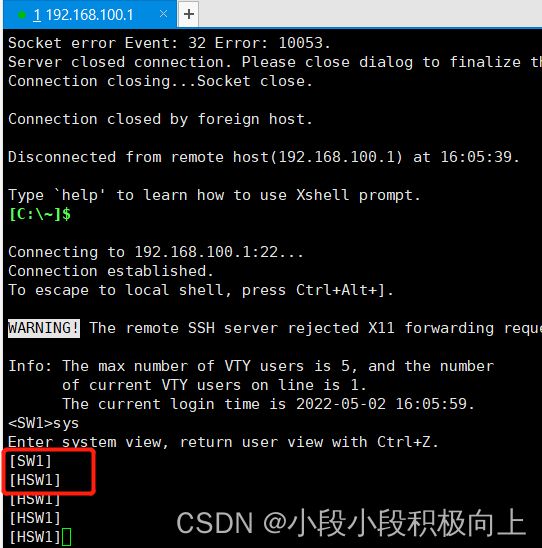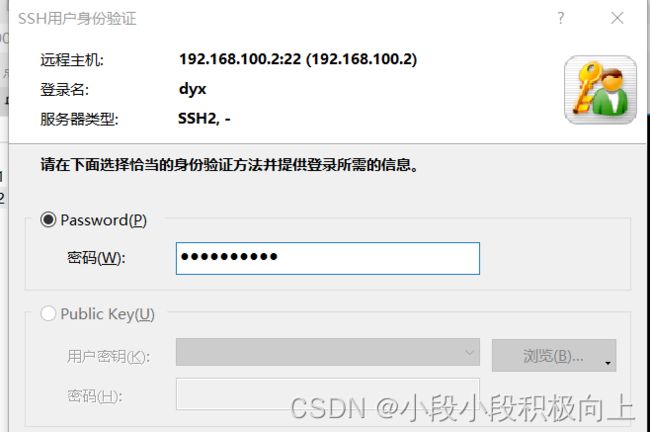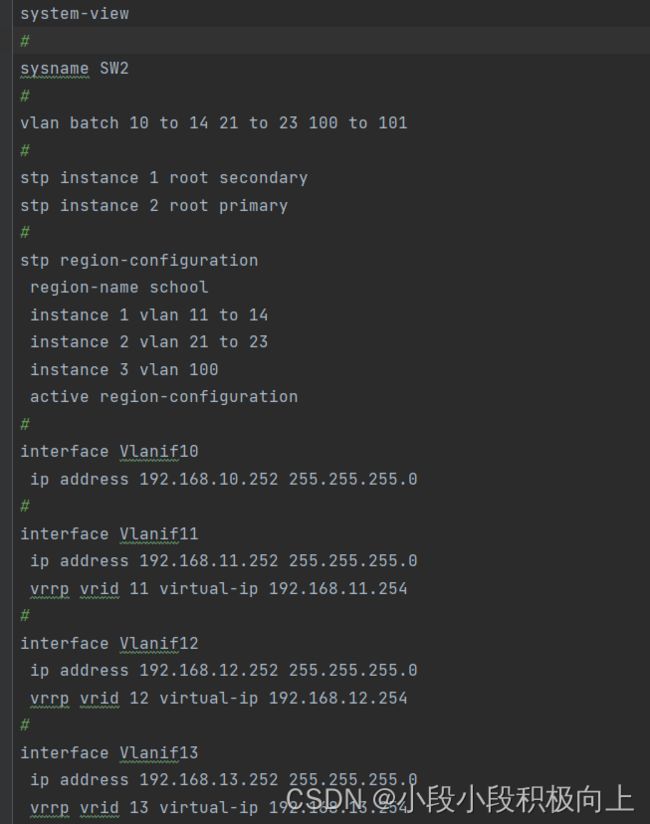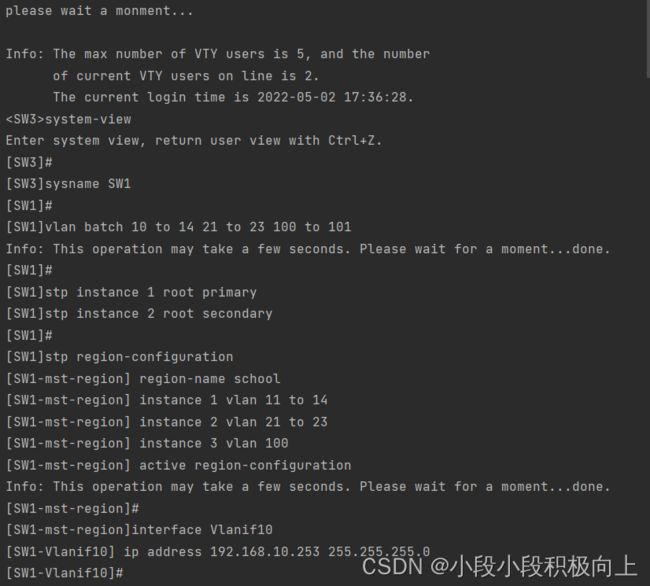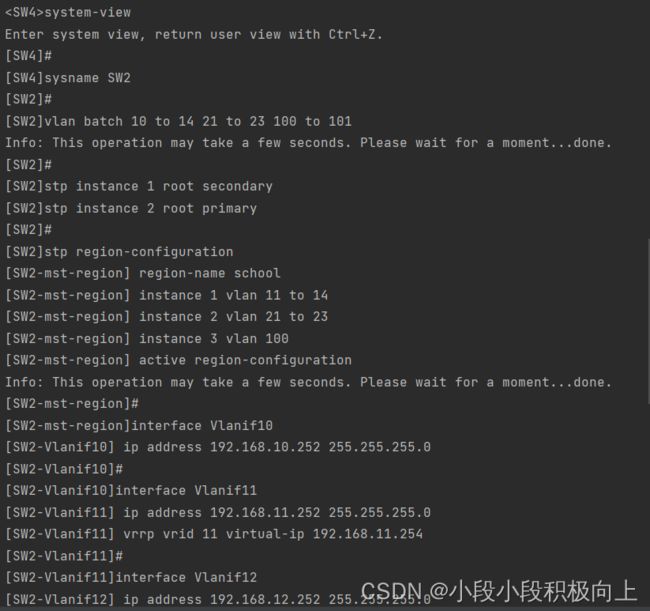python自动化运维网络设备
sw1:
二层 vlan Trunk STP Ether-trunk
sw1上
[sw1]vlan batch 100
[sw1] int g0/0/1
[sw1-GigabitEthernet0/0/1]port link-type trunk
[sw1-GigabitEthernet0/0/1]port trunk allow-pass vlan 100
[sw1-GigabitEthernet0/0/1]int g0/0/2
[sw1-GigabitEthernet0/0/2]port link-type trunk
[sw1-GigabitEthernet0/0/2] port trunk allow-pass vlan 100
[sw1-GigabitEthernet0/0/2]int g0/0/24
[sw1-GigabitEthernet0/0/24]port link-type trunk
[sw1-GigabitEthernet0/0/24]port trunk allow-pass vlan 100
[sw1]interface g 0/0/3
[sw1-GigabitEthernet0/0/3]port link-type access
[sw1-GigabitEthernet0/0/3]port default vlan 100
[sw1]stp enable
[sw1]stp root primary
sw2上
[sw2]vlan batch 100
![]()
[sw2]int g0/0/1
[sw2-GigabitEthernet0/0/1] port link-type trunk
[sw2-GigabitEthernet0/0/1] port trunk allow-pass vlan 100
[sw2-GigabitEthernet0/0/1]int g0/0/2
[sw2-GigabitEthernet0/0/2] port link-type trunk
[sw2-GigabitEthernet0/0/2] port trunk allow-pass vlan 100
[sw2-GigabitEthernet0/0/2]int g0/0/24
[sw2-GigabitEthernet0/0/24] port link-type trunk
[sw2-GigabitEthernet0/0/24] port trunk allow-pass vlan 100
sw3上
[sw3]vlan batch 100
[sw3]int g0/0/1
[sw3-GigabitEthernet0/0/1]port link-type trunk
[sw3-GigabitEthernet0/0/1] port trunk allow-pass vlan 100
[sw3-GigabitEthernet0/0/1]int g0/0/2
[sw3-GigabitEthernet0/0/2]port link-type trunk
[sw3-GigabitEthernet0/0/2] port trunk allow-pass vlan 100
Sw4上
[sw4]vlan batch 100
[sw4]int g0/0/1
[sw4-GigabitEthernet0/0/1] port link-type trunk
[sw4-GigabitEthernet0/0/1] port trunk allow-pass vlan 100
[sw4-GigabitEthernet0/0/1]int g0/0/2
[sw4-GigabitEthernet0/0/2] port link-type trunk
[sw4-GigabitEthernet0/0/2] port trunk allow-pass vlan 100
三层 IP地址
[sw1]interface vlanif 100
[sw1-Vlanif100]ip address 192.168.100.1 24
[sw2]int vlan 100
[sw2-Vlanif100]ip address 192.168.100.2 24
[sw3]int vlan 100
[sw3-Vlanif100]ip address 192.168.100.3 24
[sw4]int vlan 100
[sw4-Vlanif100]ip address 192.168.100.4 24
交换机部署ssh
sw1
[sw1]dsa local-key-pair create
#认证形式 密码认证
[sw1]ssh user dyx authentication-type password
#登录类型
[sw1]ssh user dyx service-type stelnet
![]()
#开启ssh登录
[sw1]stelnet server enable
#开放vty 端口,能被远程登录
#开放编号0 1 2 3 4 的vty端口,同时支持五个远程用户连接
[sw1]user-interface vty 0 4
![]()
#认证模式为aaa---àauthentication 认证(谁能登录进来)
# -----àauthorizathon授权 (谁进来能干什么)
# -----à according 审计 (谁进来干了什么)
[sw1-ui-vty0-4]authentication-mode aaa
![]()
#登录进来的协议是ssh
[sw1-ui-vty0-4] protocol inbound ssh
![]()
sw1上
[sw1]aaa
[sw1-aaa]local-user dyx password cipher Huawei@123
Info: Add a new user.
#授权
[sw1-aaa]local-user dyx privilege level 15
![]()
[sw1-aaa]local-user dyx service-type ssh
![]()
在sw2上
[sw2]ssh user dyx authentication-type password
Info: Succeeded in adding a new SSH user.
[sw2]ssh user dyx service-type stelnet
[sw2]stelnet server enable
Info: Succeeded in starting the Stelnet server.
[sw2]user-interface vty 0 4
[sw2-ui-vty0-4]authentication-mode aaa
[sw2-ui-vty0-4]protocol inbound ssh
[sw2-ui-vty0-4]q
[sw2]aaa
[sw2-aaa]local-user dyx password cipher Huawei@123
Info: Add a new user.
[sw2-aaa]local-user dyx privilege level 15
[sw2-aaa]local-user dyx service-type ssh
在sw3上
[SW3]ssh user dyx authentication-type password
Info: Succeeded in adding a new SSH user.
[SW3]ssh user dyx service-type stelnet
[SW3]stelnet server enable
Info: Succeeded in starting the Stelnet server.
[SW3]user-interface vty 0 4
[SW3-ui-vty0-4]authentication-mode aaa
[SW3-ui-vty0-4]protocol inbound ssh
[SW3-ui-vty0-4]q
[SW3]aaa
[SW3-aaa]local-user dyx password cipher Huawei@123
Info: Add a new user.
[SW3-aaa]local-user dyx privilege level 15
[SW3-aaa]local-user dyx service-type ssh
在sw4上
[SW4]ssh user dyx authentication-type password
Info: Succeeded in adding a new SSH user.
[SW4]ssh user dyx service-type stelnet
[SW4]stelnet server enable
Info: Succeeded in starting the Stelnet server.
[SW4]user-interface vty 0 4
[SW4-ui-vty0-4]authentication-mode aaa
[SW4-ui-vty0-4]protocol inbound ssh
[SW4-ui-vty0-4]q
[SW4]aaa
[SW4-aaa]local-user dyx password cipher Huawei@123
Info: Add a new user.
[SW4-aaa]local-user dyx privilege level 15
[SW4-aaa]local-user dyx service-type ssh
实例一:
import paramiko
import time
# 1.创建SSH客户端对象
ssh = paramiko.SSHClient()
ssh.set_missing_host_key_policy(paramiko.AutoAddPolicy())
# 使用客户端 ,导入参数: hostname="192.168.100.1", username="dyx", password="Huawei@123"
ssh.connect(hostname="192.168.100.1", username="dyx", password="Huawei@123")
command = ssh.invoke_shell() # 创建一个 命令对象,调用 shell
# 给设备发送配置命令(将发送的命令,字符串的形式转换成 utf-8 格式的二进制,传递给网络设备)
command.send("system-view \n".encode())
command.send("sys HSW1 \n".encode())
time.sleep(1) # 发送完命令,需要一个延时,等待设备 将回显值回传,等待时间不能太短
output = command.recv(65535) # 接收服务器的返回数据
print(output.decode()) # 将接收的数据解码
ssh.close() # 程序结束了,关闭连接
X-shell
实例二:
import paramiko
import time
# 1.创建SSH客户端对象
ssh = paramiko.SSHClient()
ssh.set_missing_host_key_policy(paramiko.AutoAddPolicy())
# 使用客户端 ,导入参数: hostname="192.168.100.2", username="dyx", password="Huawei@123"
ssh.connect(hostname="192.168.100.2", username="dyx", password="Huawei@123")
command = ssh.invoke_shell() # 创建一个 命令对象,调用 shell
# 读取配置文件,将读取到的每一行,发送给 设备
with open('SW1.cfg', "r", encoding='utf-8') as f:
while True:
content = f.readline()
if not content:
break
command.send(content.encode())
print("please wait a monment...")
time.sleep(5) # 发送完命令,需要一个延时,等待设备 将回显值回传,等待时间不能太短
output = command.recv(65535) # 接收服务器的返回数据
print(output.decode()) # 将接收的数据解码
ssh.close() # 程序结束了,关闭连接
![]()
运行后
实例三:
import paramiko
import time
from device_info import *
# 需要一个数据库,存储着 各个设备的信息
for item in range(len(datebase)): # range(len(datebase)---> 0-->3
ssh = paramiko.SSHClient()
ssh.set_missing_host_key_policy(paramiko.AutoAddPolicy())
ssh.connect(hostname=datebase[item]["ip_add"], username=datebase[item]["username"],
password=datebase[item]["passwd"])
command = ssh.invoke_shell()
with open(datebase[item]["path"], "r", encoding='utf-8') as f:
while True:
content = f.readline()
if not content:
break
command.send(content.encode())
print("please wait a monment...")
time.sleep(5)
output = command.recv(65535)
print(output.decode())
# 程序运行结束提示!
done()
ssh.close()
dict_SW1 = {"ip_add": "192.168.100.3", "username": "dyx", "passwd": "Huawei@123", "path": "SW1.cfg"}
dict_SW2 = {"ip_add": "192.168.100.4", "username": "dyx", "passwd": "Huawei@123", "path": "SW2.cfg"}
datebase = [dict_SW1, dict_SW2]
def done():
print("""
8
8
.oPYo8 .oPYo. odYo. .oPYo.
8 8 8 8 8' `8 8oooo8
8 8 8 8 8 8 8.
`YooP' `YooP' 8 8 `Yooo'
:.....::.....:..::..:.....:
:::::::::::::::::::::::::::
:::::::::::::::::::::::::::
""")
运行后


































